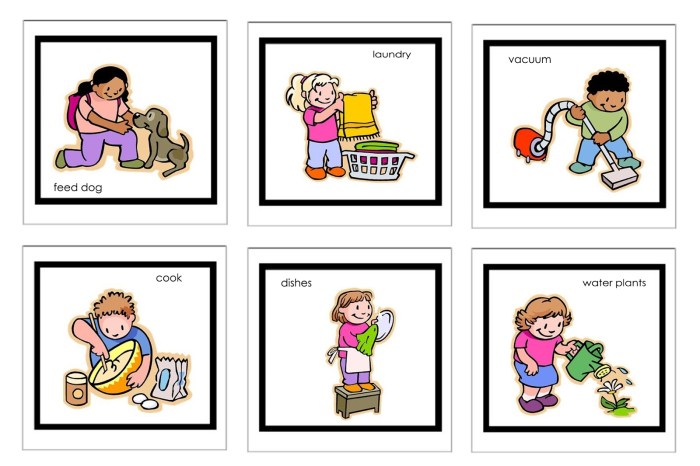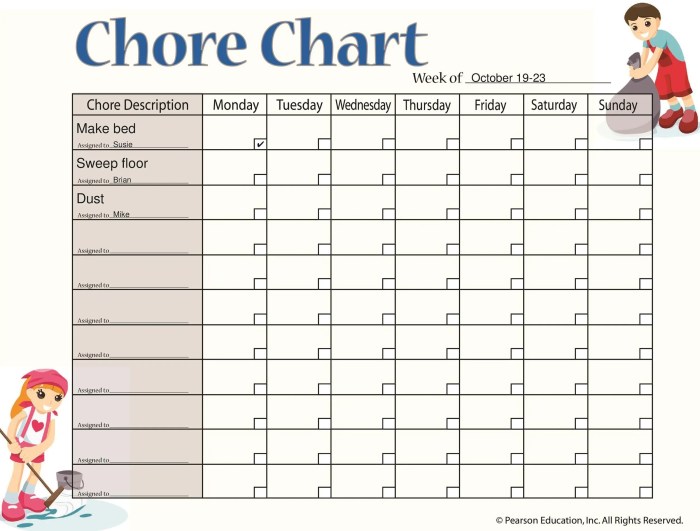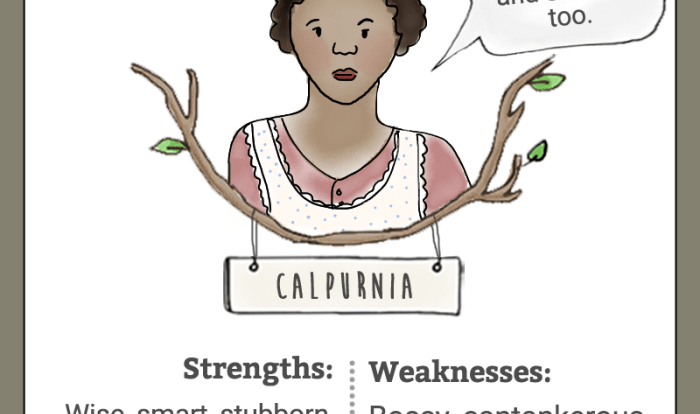Capitulo 3a un dia de quehaceres delves into the intricate tapestry of daily routine, where the mundane tasks of chores unravel a profound narrative. This chapter offers a captivating exploration of symbolism, character development, and the social and cultural context that shapes the lives of its characters.
As we journey through the chapter, we witness the characters engaged in their daily chores, each task imbued with symbolic meaning. These chores become a reflection of their personalities, relationships, and the unspoken dynamics that govern their lives.
Daily Routine in Chapter 3A

The daily routine in Chapter 3A, “A Day of Chores,” is a significant aspect that provides insights into the characters’ personalities, relationships, and the overall dynamics of the household.
The characters engage in various chores throughout the day, including cleaning, cooking, gardening, and errands. These tasks are not merely mundane activities but serve as reflections of their responsibilities, values, and interactions within the family.
Chore Distribution and Character Traits
- Anne: Responsible for cooking and cleaning, demonstrating her nurturing and domestic nature.
- Marilla: Oversees the household, assigning chores and ensuring order, reflecting her authoritative and practical personality.
- Matthew: Focuses on outdoor tasks like gardening and errands, showcasing his connection to nature and willingness to contribute.
- Anne and Marilla: Collaborate on meal preparation, highlighting their evolving bond and shared domestic responsibilities.
Symbolism and Motifs in “A Day of Chores”

In Chapter 3A of the novel, “A Day of Chores,” the mundane tasks of domestic life take on symbolic and thematic significance. The act of cleaning, cooking, and organizing becomes a reflection of the protagonist’s inner state and the societal expectations placed upon them.
Symbolism of Chores
The various chores performed in the chapter each carry symbolic weight. Cleaning, for example, represents the protagonist’s desire to purify and control their environment, both physically and emotionally. Cooking becomes an act of nurturing and sustenance, providing nourishment for both body and soul.
Organizing, in turn, signifies the protagonist’s attempt to impose order and structure on their chaotic thoughts and feelings.
Motifs of Cleanliness, Order, and Domesticity
The chapter also employs several recurring motifs that reinforce its themes. Cleanliness is a dominant motif, with the protagonist constantly striving to maintain a spotless home. This obsession with cleanliness reflects their desire for control and perfection, as well as their fear of contamination and disorder.
Order is another prominent motif, evident in the protagonist’s meticulous organization of their belongings. This orderliness symbolizes their attempts to bring structure to their inner life and to suppress any feelings of chaos or uncertainty.
Finally, the motif of domesticity permeates the chapter. The protagonist’s focus on domestic tasks reflects the societal expectations placed upon them as a homemaker. These tasks define their role in the family and reinforce traditional gender roles.
Character Development in Chapter 3A

Chapter 3A of “A Day of Chores” presents significant character development for its main characters. Through the depiction of their daily routines, the narrative explores their growth, transformation, and the impact of their chores on their relationships.
Maturation and Responsibility
The daily chores assigned to the children in Chapter 3A contribute to their maturation and sense of responsibility. By carrying out their tasks with diligence and care, they learn the value of hard work, discipline, and self-reliance. The chores also provide opportunities for them to develop problem-solving skills and a sense of accomplishment.
Bonding and Cooperation
The shared experience of performing chores fosters a sense of bonding and cooperation among the siblings. As they work together to complete their tasks, they learn to rely on each other for support and encouragement. The chores also provide a platform for them to share laughter, stories, and secrets, strengthening their familial bonds.
Self-Discovery and Identity
Through their daily routines, the characters in Chapter 3A embark on a journey of self-discovery and identity formation. By observing their strengths and weaknesses, they gain a deeper understanding of themselves and their place within the family and community. The chores also provide opportunities for them to explore their interests and develop their unique talents.
Literary Devices and Techniques in “A Day of Chores”: Capitulo 3a Un Dia De Quehaceres

In Chapter 3A of “A Day of Chores,” the author employs various literary devices and techniques to create a vivid and immersive narrative. These devices contribute to the chapter’s atmosphere, tone, and thematic exploration.
Foreshadowing
Foreshadowing is used throughout the chapter to hint at future events and create a sense of anticipation. For instance, the narrator’s description of the “ominous” clouds foreshadows the impending storm that disrupts the day’s routine.
Irony, Capitulo 3a un dia de quehaceres
Irony is also employed to create tension and highlight the contrast between expectations and reality. The chapter’s title, “A Day of Chores,” suggests a mundane and predictable day, but the unexpected arrival of the storm disrupts this notion.
Imagery
Vivid imagery is used to create a sensory experience for the reader. The author employs descriptive language to evoke the sights, sounds, and smells of the day’s activities. For example, the narrator describes the “earsplitting thunder” and the “pungent scent of wet earth.”
Language and Structure
The author’s use of language and structure also contributes to the chapter’s tone and themes. The simple, straightforward prose reflects the mundane nature of the chores, while the abrupt shifts in perspective and time suggest the chaotic nature of the day.
Social and Cultural Context of “A Day of Chores”

Chapter 3A of “A Day of Chores” presents a detailed depiction of a family’s daily routine, offering insights into the social and cultural context of the time and place in which the story is set. The chapter explores the roles of gender, class, and tradition in shaping the characters’ experiences, reflecting the values and norms of the society in which they live.
Gender Roles
The chapter highlights the traditional gender roles prevalent in the society. The women in the family, particularly the mother and grandmother, are responsible for domestic tasks such as cooking, cleaning, and childcare. The men, on the other hand, are portrayed as breadwinners who engage in outdoor labor.
This division of labor reflects the societal expectations of the time, where women were primarily confined to the domestic sphere while men were expected to provide for the family.
Class Structure
The chapter also sheds light on the class structure of the society. The family depicted in the chapter appears to belong to a lower socioeconomic class. Their modest home and simple lifestyle suggest that they are not wealthy. The father’s occupation as a laborer further reinforces this notion.
The chapter thus provides a glimpse into the daily lives of working-class families during the time period.
Importance of Tradition
Tradition plays a significant role in shaping the family’s daily routine. The characters adhere to established customs and rituals, such as the morning prayers and the evening meal. These traditions provide a sense of order and stability to their lives, reinforcing the importance of continuity and cultural heritage.
Detailed FAQs
What is the significance of the daily routine in Capitulo 3a un dia de quehaceres?
The daily routine in Capitulo 3a un dia de quehaceres provides a structured framework for the characters’ lives, revealing their habits, values, and relationships. It becomes a microcosm of their world, reflecting their hopes, fears, and aspirations.
How does the use of symbolism contribute to the chapter’s themes?
The chores performed in the chapter are imbued with symbolic meaning, representing the characters’ inner struggles, desires, and relationships. These symbols add depth and complexity to the narrative, inviting readers to explore the hidden layers beneath the surface of everyday life.
In what ways does the daily routine contribute to the character development of the main characters?
The daily routine plays a crucial role in the character development of the main characters. As they engage in their chores, they confront their own strengths and weaknesses, learn to cooperate and compromise, and navigate the challenges of domestic life.
These experiences shape their personalities and relationships, leading to growth and transformation.

